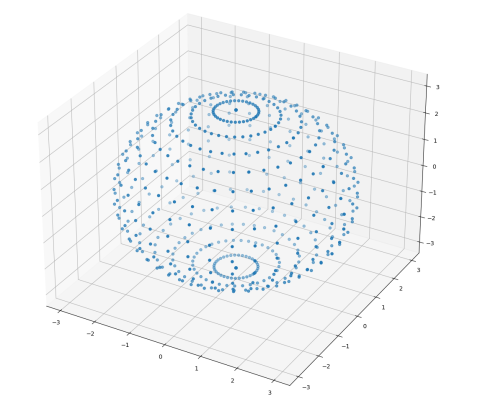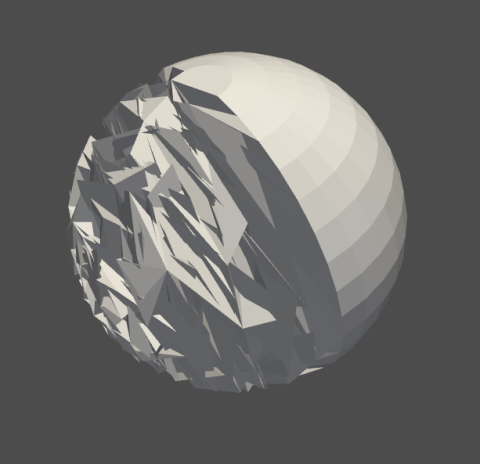Problem
I am trying to implement Edelsbrunner’s Algorithm for the alpha shape of a 3D point cloud in python as presented in this SO post. However, I’m having trouble plotting results. Half my sphere looks good, and the other half garbled.
I suspect it may have something to do with the fact that I have negative coordinates, but I’m not sure.
Definitions
I’m adding these so programmers can contribute without being bogged down by math. These are simplified definitions and not meant to be precise (Feel free to skip this part; for more, see see Introduction to Alpha Shapes and Discrete Differential Geometry):
-
Delaunay triangulation: for a 2D point set, a tesselation of the points into triangles (i.e. “triangulation”) where the circumscribed circle (i.e. “circumcircle”) about every triangle contains no other points in the set. For 3D points, replace “triangle” with “tetrahedron” and “circumcircle” with “circumsphere”.
-
Affinely independent: a collection of points
p0, ..., pksuch that all vectorsvi := pi-p0are linearly independent (i.e. in 2D not collinear, in 3D not coplanar); also called “points in general position” -
k-simplex: the convex hull of k+1 affinely-independent points; we call the points its vertices.
0-simplex = point (consists of 0+1 = 1 points)
1-simplex = line (consists of 1+1 = 2 points)
2-simplex = triangle (consists of 2+1 = 3 points)
3-simplex = tetrahedron (consists of 3+1 = 4 points)
-
face: any simplex whose vertices are a subset of the vertices of another simplex; i.e. “a part of a simplex”
-
(geometric) simplicial complex: a collection of simplices where (1) the intersection of two simplices is a simplex, and (2) every face of a simplex is in the complex; i.e. “a bunch of simplices”
-
alpha-exposed: a simplex within a point set where the circle (2D) or ball (3D) of radius alpha through its vertices doesn’t contain any other point in the point set
-
alpha shape: the boundary of all alpha-exposed simplices of a point set
Algorithm
Edelsbrunner’s Algorithm is as follows:
Given a point cloud
pts:
- Compute the Delaunay triangulation
DTof the point cloud- Find the alpha-complex: search all simplices in the Delaunay triangulation and (a) if any ball around a simplex is empty and has
a radius less thanalpha(called the “alpha test”), then add it to the
alpha complex- The boundary of the alpha complex is the alpha shape
Code
from scipy.spatial import Delaunay
import numpy as np
from collections import defaultdict
from matplotlib import pyplot as plt
import pyvista as pv
fig = plt.figure()
ax = plt.axes(projection="3d")
plotter = pv.Plotter()
def alpha_shape_3D(pos, alpha):
"""
Compute the alpha shape (concave hull) of a set of 3D points.
Parameters:
pos - np.array of shape (n,3) points.
alpha - alpha value.
return
outer surface vertex indices, edge indices, and triangle indices
"""
tetra = Delaunay(pos)
# Find radius of the circumsphere.
# By definition, radius of the sphere fitting inside the tetrahedral needs
# to be smaller than alpha value
# http://mathworld.wolfram.com/Circumsphere.html
tetrapos = np.take(pos,tetra.vertices,axis=0)
normsq = np.sum(tetrapos**2,axis=2)[:,:,None]
ones = np.ones((tetrapos.shape[0],tetrapos.shape[1],1))
a = np.linalg.det(np.concatenate((tetrapos,ones),axis=2))
Dx = np.linalg.det(np.concatenate((normsq,tetrapos[:,:,[1,2]],ones),axis=2))
Dy = -np.linalg.det(np.concatenate((normsq,tetrapos[:,:,[0,2]],ones),axis=2))
Dz = np.linalg.det(np.concatenate((normsq,tetrapos[:,:,[0,1]],ones),axis=2))
c = np.linalg.det(np.concatenate((normsq,tetrapos),axis=2))
r = np.sqrt(Dx**2+Dy**2+Dz**2-4*a*c)/(2*np.abs(a))
# Find tetrahedrals
tetras = tetra.vertices[r<alpha,:]
# triangles
TriComb = np.array([(0, 1, 2), (0, 1, 3), (0, 2, 3), (1, 2, 3)])
Triangles = tetras[:,TriComb].reshape(-1,3)
Triangles = np.sort(Triangles,axis=1)
# Remove triangles that occurs twice, because they are within shapes
TrianglesDict = defaultdict(int)
for tri in Triangles:TrianglesDict[tuple(tri)] += 1
Triangles=np.array([tri for tri in TrianglesDict if TrianglesDict[tri] ==1])
#edges
EdgeComb=np.array([(0, 1), (0, 2), (1, 2)])
Edges=Triangles[:,EdgeComb].reshape(-1,2)
Edges=np.sort(Edges,axis=1)
Edges=np.unique(Edges,axis=0)
Vertices = np.unique(Edges)
return Vertices,Edges,Triangles
def ptcloud_sphere():
r = 3
phi = np.linspace(0, np.pi, 18)
theta = np.linspace(0, 2 * np.pi, 36)
PHI, THETA = np.meshgrid(phi, theta)
x = r * np.sin(PHI) * np.cos(THETA)
y = r * np.sin(PHI) * np.sin(THETA)
z = r * np.cos(PHI)
ax.scatter(x, y, z)
plt.show()
pts = np.stack((x.ravel(), y.ravel(), z.ravel()), axis=1)
return np.unique(pts, axis=0)
if __name__ == "__main__":
pts = ptcloud_sphere()
verts, edges, faces = alpha_shape_3D(pts, alpha=10)
faces_conn_list = np.insert(faces, 0, 3, axis=1)
num_faces = faces.shape[0]
mesh = pv.PolyData(pts[verts], faces_conn_list, n_faces=num_faces)
plotter.add_mesh(mesh, reset_camera=True)
plotter.show()
Output
Point Cloud:
Alpha Shape:

